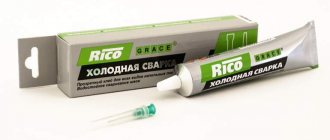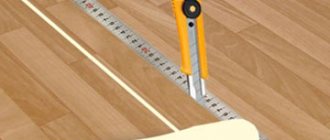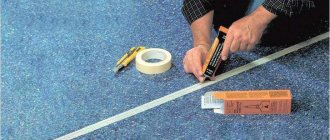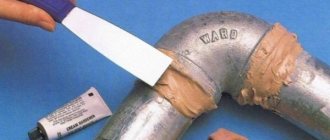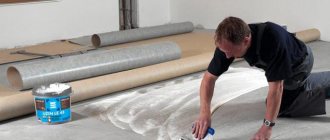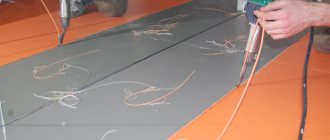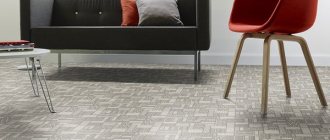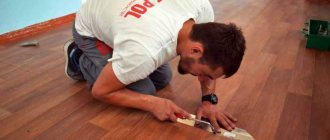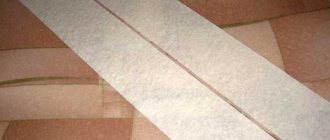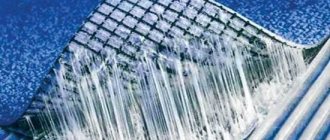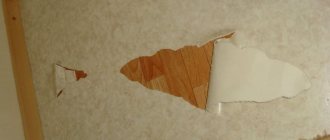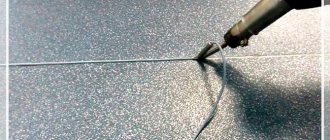What it is
Cold welding of floor coverings is a chemical method of joining materials that does not involve the high temperatures associated with conventional welding.
The adhesive composition, entering into a polymerization reaction with the linoleum material, dissolves and melts the edges of the canvases. Their plastic deformation occurs. After completing the process of interaction of the mixture with the coating, a strong seam is formed at the joints of the sheets, and the structure is uniform in structure with the material being joined.
With a high-quality connection of the canvases, the joining seam is not noticeable.
The popularity of using adhesives for joining linoleum cloths of the “cold welding” type is due to the ease of working with them, the relative low cost and the versatility of the method.
Description and purpose
“Cold welding” is a simple and convenient method of connecting strips of linoleum to each other using an adhesive composition. This product operates on the principle of a solvent. The edges of linoleum melt when applied, as a result of which they are easily connected to other parts of the floor covering. “Cold welding” leaves thin seams that are almost invisible to the human eye. In terms of elasticity and strength, these seams are in no way inferior to the main linoleum sheet.
The purpose of “Cold Welding” is to reliably bond any type of linoleum, whether installing a new coating or repairing an old one. Benefits include:
- visually invisible monolithic seams;
- no need for professional skills and specialized equipment for work;
- low consumption of funds;
- minimal time investment;
- gluing complex joints of any configuration and thickness;
- democratic price.
Compound
The typical chemical composition of reactive adhesives is simplistically a mixture of solvent and filler. The concentration of these two components determines the type and technology of work.
Solvent
The following can be used as a solvent in compounds for polyvinyl chloride coating:
- Tetrahydrofuran is a compound from the ether family. It can account for up to 80% of the total volume of the mixture.
- Acetone is a common ingredient in adhesive mixtures that have fast-setting properties.
Given the good solvent properties of acetone, it can be used to make glue at home.
Finely chopped pieces of old linoleum without a base are poured with this solvent and left for at least a day until a homogeneous consistency is obtained.
Glue made from solvent and linoleum residues
But it should be borne in mind that such glue will be significantly lower in quality than factory mixtures that contain special fillers.
Adhesive
Various additives serve as additives for adhesive fillers in mixtures intended for soldering linoleum:
- plasticizers;
- polyvinyl chloride;
- polyurethane;
- PSH-LS resins.
Pigments and modifiers can also be added to the adhesive mixture. Some manufacturers, for reasons of trade secrets, do not advertise information about component substances.
Types of cold welding for linoleum
There are three main types of compositions for non-thermal joining of linoleum - A, C and T. This classification was introduced by Werner Müller, a German manufacturer of cold welding systems for PVC coatings.
The letter designations to some extent reflect the shape of the nozzles.
Cold welding systems
The existing differences, mainly in the concentration of the mixture, determine the purposes for which they can be used, the types of work, as well as the material of the coating itself and its base.
The compounds are packaged in tubes equipped with various types of tips and nozzles, which allows you to place the mixture precisely into a narrow seam.
Cold welding adhesive type A
Type A compound is characterized by the following properties:
- instant readiness for use, the possibility of repeated use with good sealing of the packaging;
- consistency is more liquid than other types, due to the predominance of solvent in the mixture;
- deep and rapid penetration into the coating structure;
- high strength of connections;
- waterproofness and durability of the seam.
Feature - the tube is equipped with a built-in steel needle, which is closed with a special cap.
Type A glue
The technology for working with this glue is not complicated, but to obtain a high-quality result from soldering, it is necessary to properly prepare the joints. The needle should be inserted into the seam deeply, in doses and filling it evenly.
Adhesive type C
Mixture C has a thick paste-like consistency. Liquid PVC in it predominates over the solvent. This glue is usually used to repair existing coatings.
The set includes a narrow C-nozzle, which is used depending on the width of the seam (from 0.3 to 2 mm). To join wider (up to 4 mm) gaps, no nozzle is needed.
Type C nozzle
By carefully squeezing the paste out of the tube, which is held vertically or at a slight angle to the coating, the seam is uniformly filled with welding.
Type T
In terms of the method of preparing the seam, glue T is similar to type A. The joint of the sheets is done using the method of a tightly cut seam.
Feature - the function of a needle is performed by the included nozzle in the shape of the letter T.
Type of T-nozzle
Useful properties:
- alignment of protruding edges of canvases;
- low absorbency of the base with pile.
The soldering technology is similar to the welding method A.
Connection methods
Creating high-quality flooring requires good experience, knowledge of technological fundamentals, a competent approach to work, and accuracy. When laying linoleum, hiccups and unusual situations often arise where the right decision must be made. In particular, when joining different pieces of coating, visible discrepancies may appear. Cold welding adhesive for linoleum helps to hide the seams and create the appearance of a solid canvas. There are two bonding methods - cold and hot. To obtain high-quality joints, you need to take into account the type of product and use it in accordance with the rules and recommendations.
There are several ways to combine sheets
Hot welding
High-temperature connection of parts of the coating occurs using special tools - a machine and a cord for welding linoleum. This type of work is painstaking and is carried out only by experienced professionals. Hot welding of linoleum is widely used to create flooring in public spaces where the floor is subject to heavy mechanical load. This method provides strong adhesion, but is very expensive.
This one is quite expensive and costly
Cold welding
Another method of processing seams, which does not use high temperature, is widely used in everyday life. This welding of linoleum involves joining the sheets with a specially designed glue. The binder composition is a solvent that can temporarily transform the material into a liquefied state. The edges are then joined and the solvent evaporates, leaving behind a neat, high-strength joint.
The glue is easy to use
The end result of a cold connection is in no way inferior in quality to the coating treated with temperature. In this case, there is no need to buy an expensive machine for welding linoleum. For this reason, it is recommended to use the cold method, in which it is possible to obtain an intricate seam, even if its shape and configuration are complex.
How much does cold welding for linoleum cost? The price of the composition varies from 150 to 550 rubles. The main disadvantage of cold bonding is the content of volatile compounds in the glue that are harmful to human health. When processing seams, the room must be well ventilated.
Be sure to ventilate the room
Criterias of choice
The efficiency of welding linoleum coating depends on the selection of the adhesive composition. All types of mixtures for non-thermal gluing of PVC have a transparent structure and do not disturb the color scheme in the seam area.
But it is necessary to take into account a number of conditions that determine the use of different types of adhesives.
The choice depends on the type of linoleum
Adhesive mixtures A and C are used with PVC coatings.
Class T cold soldering compound is used when connecting:
- polyester materials;
- heavy multi-layer commercial fabrics;
- linoleum on a duplicated basis.
This is a material based on felt (textile) and fiberglass.
Duplicated linoleum
Attention! Type A mixture is not suitable for soldering linoleum on a felt base.
Cover age
When working on cold soldering, it is necessary to take into account the properties of the coating:
- Compound A is used to join new linoleum;
- more viscous composition C - for repairing old coatings;
- T-class can be used to work with material of any age, but new installation is preferable.
Quality and shape of linoleum cutting
To achieve a good result in terms of strength and appearance of the seam when joining fabrics with compositions A and T, it is necessary that the joint be prepared with high quality, without cracks.
Preparation of the joint of the panels
The use of type C welding does not imply strict requirements for the quality of preparation of the panels for gluing. The predominance of polyvinyl chloride in this mixture allows:
- fill wide, up to 4 mm, seams;
- solder uneven edges of the canvas;
- join fabrics with complex cutting shapes, make appliqués.
Experience of the person who will perform the work
The simplest technology is considered to be joining linoleum sheets or repairing them using a more viscous composition of grade C.
With some skills, working with mixture “A” is not very difficult. An inexperienced repairman can also handle them.
But technical difficulties may arise with T-welding of multilayer semi-commercial and commercial coatings of a higher class. Therefore, repair specialists often work with this compound.
Existing methods of joining materials
It would be wrong to label and categorically state that there are good and bad docking methods. Since these methods exist, it means that they are in demand in some niche. Since linoleum joints can be glued together in different ways, the main thing here is to correctly determine which method is suitable in a particular case.
Method No. 1 - landing with double-sided tape
Let us say right away that this method is fast, very easy to implement, but not very reliable and not durable. After all, adhesive tape, even the highest quality, was originally developed for temporary, lightly loaded connections.
Double sided tape.
Double-sided tape is a good thing, but it has one flaw: such tape will not adhere tightly to a porous surface. Therefore, before installation, any base, be it a cement screed, wood or a concrete slab, must be treated with strengthening soil.
A felt-based covering cannot be properly joined using double-sided tape.
Felt-based linoleum.
When the soil has dried, you need to remove the protective tape from below and glue the tape itself to the base. After this, with one hand you pull off the top protective tape, and with the other hand you simultaneously press the edges of the joined sheets. Upon completion of this procedure, it is advisable to roll the joint well with a hard roller. That's actually all the wisdom.
In fact, this method has only two main and only advantages. It's low price and simple. Otherwise, I personally can recommend it as a temporary option lasting a maximum of a year. Then you will have to glue it as expected or change the coating.
Method No. 2 - overhead sill
The range of plastic and metal sills, although not particularly large, is usually possible to choose from.
As for complexity, the instructions for installing such thresholds with your own hands are not far removed from double-sided tape.
Overlay threshold.
- Each such threshold has ready-made holes for fixing with self-tapping screws . First, you need to cut the strip to size and, placing it at the junction of the two panels, mark the entry points of the screws;
- After this, take an electric drill and use a six-millimeter drill to make a series of holes according to the markings . Plastic dowels are immediately inserted into these holes;
- Now all you have to do is attach the bar and secure it with self-tapping screws.
Thresholds with holes for screws.
Everything would seem beautiful, but the problem is that the threshold is overhead, naturally it will stand out strongly on the floor surface. Since it is not necessary to glue the linoleum here, in fact, you just press it well, this method is perfect as an interior transition in the area of the doorway. Or to connect two different coatings, for example, tiles and linoleum.
Method No. 3 - mastic
This method can safely be considered the patriarch of this direction. Mastic is a type of adhesive. In those days when the range of linoleum was, to put it mildly, small, all coatings of this type were glued to the base using mastic. The method is quite reliable, but if everything is done as expected, it will not be possible to dismantle such a canvas without tearing it.
Nowadays, quite often people prefer to use mastic only to join two canvases. Many craftsmen believe that gluing linoleum over the entire area is only relevant for industrial and public premises with high loads, and on this I agree with them. At home, there is no point in completely fixing the canvas; it won’t go anywhere anyway.
Applying mastic with a spatula.
This method is somewhat reminiscent of gluing with double-sided tape. In the same way, before gluing the joints of linoleum, the base will need to be primed, and the edges of the canvases will need to be degreased with any alcohol-containing solution. Just don’t try to degrease it with acetone or any solvents, because some models of linoleum can simply be corroded by these compounds.
After this, in the area of the joint, mastic is spread on the base with a spatula, and the edges of the canvases are pressed; for reliability, you can also roll the joint with a hard roller. Only mastic is not adhesive tape; it will dry for about a day. And until it completely hardens, the edges of the linoleum should be pressed tightly. Usually a board is placed at the joint and a weight is placed on it.
Method No. 4 hot welding
Hot welding is a thorough and very reliable method, but it is not suitable for everyone. In this way, only high-density linoleum can be connected, which is most often used for arranging floors in industrial enterprises and administrative buildings. Models intended for the residential sector are too thin and “loose”; at this temperature they simply melt.
Hot air gun for hot welding.
But anything can happen in life, and perhaps in your case this will be what you need. I warn you right away that compared to other methods, hot welding is the most expensive.
To work, you will have to get a special hot air gun. In appearance, it looks like a regular soldering iron, only it is heated using hot air. In principle, the price for it is high, but the instrument is specific and highly specialized, so it is better to rent it.
Main stages of hot welding.
Hot welding can only be performed if the coating is glued over the entire area of contact with the floor. First, the canvas “sits” on the mastic, and after it has firmly set, you can begin to weld the seams.
Working with a hot air gun.
- Hot welding is similar to classical welding methods. The solder here is a special polymer cord. It is inserted into the nozzle of a hot air gun and, as it melts, fills the seam between the two sheets;
- First you will need to widen this seam. Some craftsmen prefer to simply join two edges with a small gap of 2 - 3 mm; theoretically, this can be done, but this is not entirely true. It is better to first join the two sheets without a gap, and then cut a V-shaped groove along the seam. Professionals use a special cutter for this, but at the amateur level a good sharp knife will do; I use an oblique shoe knife;
- The cross-section of the cord should be a couple of millimeters larger than the groove between the blades. It goes without saying that there should be no debris in the groove, and the edges of the linoleum should be degreased;
Scheme of hot welding of linoleum.
- Naturally, each soldering iron has instructions, plus there should also be an annotation on the packaging of the polymer cord. But if for some reason you do not have this information, then keep in mind that the average melting temperature of the polymer ranges from 300 to 500ºC;
- When the cord is inserted and the tool has reached the desired temperature, the tip is brought close to the gap between the sheets and as it fills, the hot air gun moves along the seam. I simply place the tip on the groove and move the soldering iron;
Welding kit.
It is better to solder the canvases first from one wall to the middle, and then in the same way, from the opposite wall to the middle. The joints are joined with an overlap of about 30 mm.
- The joint must be filled completely, so that the liquid polymer protrudes above the joint. If the cord doesn't melt well, add a little heat. After finishing welding, leave the joint alone so that the polymer hardens;
- Now you will need to take an arched knife and carefully cut off the excess that is protruding. Just don’t try to “put things in order” while the polymer is still liquid, the fact is that it tends to shrink and if you rush, you will have a groove in place of the seam. The best time is when the composition has already set, but is still warm.
A cutter for expanding the seam.
There is one more nuance in hot welding technology. No matter how hard you try, you will not be able to achieve an invisible seam. The welding will be clearly visible; creative individuals often use this to create original linoleum panels.
To be completely honest, hot welding is only as easy as you read about it. When it comes to direct welding, without experience, you will have to tinker a lot. Therefore, it makes sense to think about hiring a specialist.
Consumption: influencing factors and figures
Information about how many linear meters of joint a tube will be enough for is indicated by the manufacturer in the user instructions or on the packaging.
Consumption data on packaging
The amount of glue consumed for cold welding of linoleum is linked to a number of factors:
- Characteristics of the welding itself, declared by a specific manufacturer.
- Thickness of the material being joined.
- Master's qualifications (not always last).
After analyzing this information for mixtures of different brands, you can derive the average consumption rate by type of glue:
- A - 2.2 g per 1 linear. m;
- C - 3 g per 1 linear. m;
- T - 6.3 g per 1 linear. m.
It should be borne in mind that composition “C” shrinks up to 30% of the volume initially embedded in the seam. This feature makes it necessary to refill the joint with glue, sometimes several times, which increases its consumption.
Manufacturers and brands
The main manufacturers of cold welding adhesives can be judged by the rating of this product and the number of offers on the construction market.
Werner Muller
This is a world-famous German company founded by Werner Müller in Bindersheim.
Compounds for Werner Muller linoleum types A, C and T are represented by the Tarkett Rumix brand.
Brand Werner Muller Tarkett
Packaging - metal tube 50 ml.
Mixes for PVC material under this brand are distinguished by an excellent quality standard. When properly stored, they remain suitable for 3 years.
A short overview video about cold welding types from Werner Muller can be viewed below.
Cold welding Tarkett Werner Muller
Homakoll
Khomakol is a leading Russian company focused on the production of construction and industrial chemical products. Adhesive materials for household and professional use are one of its core areas.
The cold soldering adhesive from this company is represented by the S 401 brand.
Homakoll S 401
The mixture is suitable for joining all types of household and commercial PVC coatings and, according to consumer reviews, has many advantages:
- reliability of connections;
- preventing edges from beading;
- good waterproofing qualities of the seam;
- durability.
Packaging - 60 ml.
Master Teks
Adhesives and sealants produced by Mastertex (Poland, Russia) enjoy a large number of offers and good demand on the market.
Adhesive for cold soldering of linoleum and plastic is produced under the Master Teks Profmaster brand.
The basis of the adhesive composition is PVC resin.
Useful characteristics:
- the ability to glue complex figured seams and perform appliqué;
- high degree of adhesion;
- elasticity and transparency of the seam;
- moisture and heat resistance.
Master Teks glue
Package volume: 115 ml.
Opinions about felt linoleum
Felt linoleum does not require laying a backing.
In view of the fact that the product has, it is logical that there are consumer reviews about it. What are they? Let's get a look:
- “...it’s been sitting great in my hallway for a couple of years now. There is no humidity in the apartment, they mounted it on a concrete screed in one piece, did not cook anything, just pressed it with baseboards and thresholds...”;
- “...if you buy it, weld it in the store right away. It’s difficult to weld normal seams yourself at home, it’s expensive to hire a craftsman, few people take it, and the glue itself will cost a pretty penny…”;
- “...I cooked it myself, it’s okay, you just have to not twitch and do everything carefully. If something goes wrong, the seam will just be a little noticeable. But I have patterned linoleum, and in general my joints are not noticeable...”
Linoleum insulated with felt eliminates the need to take care of additional heat-insulating materials and carpets, washes well and retains its appearance for many years in a row. In addition, its cost is completely justified, because there are significant savings on adhesives, substrates and work in general.
Prices for felt linoleum range from 400 to 1500 rubles. (at an exchange rate of 1$=66 rubles). The main factors influencing the price are thickness, design and brand.
Helpful Tips for Cold Welding
To obtain a durable, high-quality and invisible seam using the non-thermal soldering method, there are several useful tips:
- carefully read the instructions for the adhesive and determine its suitability for working with a specific type of floor covering;
- with liquid compounds, the canvases are joined along an edge cut with the double-cut method - a double cut of overlapping canvases;
- the junction (edges of the canvases) and the base must be cleaned of debris and dust, degreased;
- to protect the edges of the canvas from melting, the seam is sealed with masking tape, followed by a cut in the center;
- the frequency of repeated filling of joints when the glue shrinks should be at least 2-3 hours;
- Before soldering, it is advisable to heat the seam area of hard coatings of semi-commercial and commercial classes with a hairdryer to a temperature of 40°C, but no more;
- To remove glue that accidentally gets on linoleum, you cannot use solvents - only soapy water, and as quickly as possible;
- When filling a seam with glue, you need to use two hands - guide the needle with the finger of one, and hold the tube with the other.
Technology for soldering linoleum
A prerequisite for using reactive adhesives is compliance with safety measures.
Work must be performed in a well-ventilated area, hands must be protected with gloves, eyes with goggles.
To summarize, we can say that cold soldering using high-quality modern compounds is a worthy alternative to other methods of joining linoleum, both in terms of quality and ease of execution.
Instructions for use
How to cold weld a linoleum joint? To carry out all the work correctly, you must strictly follow the instructions. It is described step by step below.
Seam formation
After purchasing the coating, its approximate fit, you need to form the optimal seam. To do this, lay both pieces as they will lie on the floor. In this case, the overlap should be 5 cm. Next, you will need a strong metal ruler and a pencil. Fasten both edges of the coating together with double-sided tape so that they do not move during cutting. Then markings are applied strictly in the middle, pressing the coating tightly with a ruler. Then they cut along the markings with a sharp knife to get even edges.
Cleaning the base and seam
Before gluing, you need to thoroughly clean the floor from dirt, remove the rest of the old coating, and vacuum it. Before work, all parts must be dried. Also, as preparation, you should protect the edges of the linoleum from damage. Cold welding contains aggressive components that can corrode the material. Glossy linoleum suffers especially badly. To avoid such troubles, you need to buy wide masking tape and cover the edges of both canvases with it, leaving a few millimeters for glue.
Cold welding application
Before work, you need to prepare a clean cloth or cotton swabs to remove excess and smudges of glue. There are two ways to apply the product:
- First. Using the tube nozzle, squeeze the glue onto both edges at once. At the junction, the linoleum will become liquid and the edges will melt.
- Second. Lubricate only one edge and place it on the floor. Then apply glue to the second edge and place it tightly next to the first. Level, smooth out the seam.
After a few hours you can walk on the floor without fear; the exact drying time is indicated in the instructions for the glue. When the linoleum is dry, you need to remove the masking tape.
Removing excess glue
Often, excess composition flows out. You should not touch them while welding the edges; this can cause the floor covering to peel off and the seam to break. Dried cold welding is removed in 2 steps. Since a fresh seam is elastic, strong tension and cutting may leave a crater. It is better to first cut off the excess that sticks out on the surface, and after a day to finish the job. You can do all the work yourself, without the help of specialists. Installing a welded seam is a painstaking task, but quite doable!
